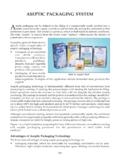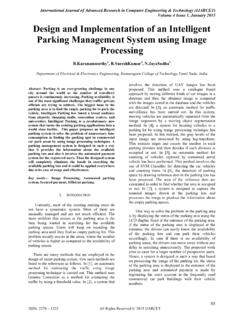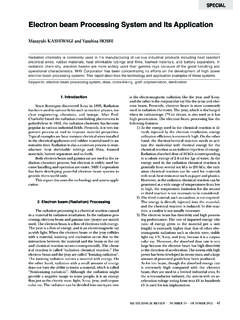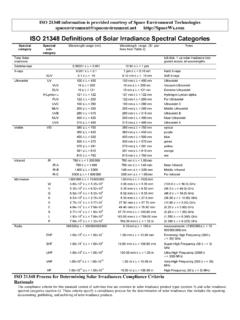Transcription of Background Gamma Radiation Mapping in …
1 IOSR Journal of Applied Physics (IOSR-JAP) e-ISSN: 6, Issue 5 Ver. II ( 2014), PP 53-61 53 | Page Background Gamma Radiation Mapping in Bangladesh: Radioactivity in the Surface Soil of BhawalGahr Area of Gazipur S. S. Islam1*,M. A. Haydar2, M. I. Ali2, D. Paul2, M. L. Ali2andS. M. A. Islam1 1 Dept. of Physics, Jahangirnagar University, Savar, Dhaka 2 Health Physics and Radioactive Waste Management Unit (HPRWMU),Institute of Nuclear Science and Technology,Atomic Energy Research Establishment,Bangladesh Atomic Energy Commission (BAEC) Savar, Dhaka, Bangladesh. Abstract:The total Background Radiation in the earth s environment is due to the contributions from natural (cosmic and terrestrial) as well as artificial (fall-out from nuclear weapon test, nuclear accidents, discharge from nuclear reactors etc.) Radiation sources. It comes mainly from uranium 238U series, thorium 232Th series and radioisotope of potassium, 40K.
2 Moreover, fission products such as 134Cs, 137Cs, 90Sr etc. may spread as fall-out Radiation in the environment. Natural environmental radioactivity depends on the geological and geographic conditions, and appears at different levels in the soils of each different geological , it is worthy of investigating Background radioactivity originating from natural and probable artificial radioactive sources. Country-wide Background Gamma Radiation Mapping program has been initiated in Bangladeshby dividing the whole country primarily into ~5 km ~5 km (1' 1' in GPS scale) systematic square grids. About 30 km 30 km area of forest land of Gazipur district called the BhawalGahr (including the Bhawal National Park) bordering Mymensinghand Tangail districts was selected for sampling for this study. Soil samples at 0-5 cm depth were collected from the grid-node points of the ray spectrometry technique using a High Purity Germanium (HPGe) detector of 20% relative efficiency was used to detect the probable radionuclides and calculate of their activity concentrations in the samples.
3 The activity concentrations of 226Ra, 232Th and 40K in these soil samples varied from to , to and to Bq/kg, Bangladesh is actively considering embarking upon nuclear power programto improve its energy mix and neighbouring countrieshave a number of nuclear power plants in operation, therefore, this Background radioactivity database would be useful as a baseline data in time of any nuclear incidentin this region. Key Words: Radionuclide; Activity Concentration; HPGe detector, Radiological Health Hazard I. Introduction Radiation is everywhere, including in the soil. Radionuclides become a part of the soil in three ways: (i) as part of Earth s original crust (primordial radionuclides) (ii) produced and deposited by cosmic ray interactions (cosmogenic radionuclides) and (iii) through man-made releases (man-made radionuclides and activities)[1]. Primordial radionuclides such as uranium-235, uranium-238, thorium-232, and potassium-40 are left over from the creation of the earth with typical have half-lives of hundreds of millions of years.
4 Primordial radionuclides end up in soil as part of the rock cycle, which includes weathering. Cosmogenic radionuclides such as carbon-14, tritium-3, and beryllium-7 are continuously produced by bombardment of stable nuclides by cosmic rays, primarily in the atmosphere and can have long half-lives, but the majority has shorter half-lives than the primordial radionuclides. Some of these radionuclides fall to earth and are deposited on the soil. The third way radionuclides enter the soil is through man-made activities, such as the fallout from atmospheric testing of nuclear weapons and radiological events like accidents and leakages from nuclear facilities. The radioactive particles from these events travel around the world on streams of air and due to the weight of the particles and weather ( , heavy rain) soonthose particles end up to the ground. Natural radioactivity in soil varies on soil type, mineral make up and density.
5 Radionuclides in the soil can move into the water, air and even our food supply. Natural radiations in the environment, nuclear tests, accidents and possible leakages from nuclear facilitiesmayresult in serious problems for environment and human radioactivity arises mainly from primordial radionuclides from the 235U,238 Uand 232Th series,followed by 40k. Gamma Radiation emitted from those naturally occurring radionuclides and from radionuclides deposited on the ground are the main external sources of Radiation exposure of the human body. Natural environmental radioactivity and associated external exposure due to Gamma Radiation depend primarily on the geological, geographical,altitude Background Gamma Radiation Mapping in Bangladesh: Radioactivity in the 54 | Page and mineralogical structures of soil and rocks[2]. Nearly eighty five per cent of the Radiation dose received by humanity comes from natural Radiation sources[3].
6 The knowledge of primordial radionuclides is an important prerequisite for the evaluation of the rate of exposure and the absorbed dose by the population. The long-lived naturally occurring radionuclides may get transferred to plants along with the nutrients during mineral uptake,accumulate in various parts and even reach in the edible portions. Abnormal occurrences of uranium and its decay products in rocks and soils and thorium in monazite sands have been identified in several areas of the world[4]. Bangladesh is operating a 3 MW nuclear research reactor, a radioisotope production facility, a high activity Gamma irradiation facility as well as other radiological facilities for the benefit of the people of the ,Bangladesh is planning to establish nuclear power plants to improve its energy mix. Neighboringcountries have a number of nuclear power plants in operation[5]. Accidents may happen in nuclear installations inside the country as well as in theneighboring countries causing the spread of radioactivity and consequently, influencing the Background Radiation leveland hence, causing the increase of exposure level to public in this region.
7 Almost every country with nuclear facilities or facilities in neighboring country has its own Background Radiation Mapping database to be used in time of any incident or accident in these nuclear facilities. The objective of the current study is to estimate the country-wide Background radioactivity (mainly- ) originating from natural and probable artificial radioactive source by dividing the whole country into reasonable systematic square grids [6-7]in order to formulate a countrywide Background radioactivity Mapping database. The current study is devised to detect the probable radionuclides and estimate their activity concentration on the surface layer of the soil in the area under study. Theinvestigation has been initiated from around the BAEC TRIGA Research Reactor (BTRR) of Bangladesh situated at Atomic Energy Research Establishment (AERE), Savar, Dhaka located near the BhawalGahr BhawalGahr is mostly an undisturbedforest area spread to the north of the BTRR, has been selected as the starting area for our investigation.
8 The results from this study would produce a baseline Radiation map for thisarea which would be used as reference information to assess any change in the Background radioactivity level due to the change in the topography of the location,settlement around it as well as any artificial influences on the study would also provide the current exposure level of the population living in this area due to this Background Radiation . II. Materials And Method Geology and Climate of the Sampling Site BhawalGahr areaof Gazipurdistrict was selected as the sampling area. The area is situated in the north, north-east and north-western part of Gazipur bordering Tangail to the west, Mymensingh to the north and Dhaka to the south. The location of BhawalGahr in the satellite map is shown in Fig. greater BhawalGahr area lies approximately between the latitude 23 54 00" N to 24 23 0" N and the longitude 90 08 00" E to 90 38 00" E. The area is the second highest terrace of the Madhupur Tract of Pleistocene age.
9 The surface elevation of the site is varying from about 10 to 15m above the Mean Sea Level (AMSL), which stands much higher than the general elevation of the surrounding flood plain area. Two characteristic geological units cover the area and the surroundings, viz. Madhupur Clay of the Pleistocene Age and alluvial deposits of Recent Age . The highland alluvium consists of sand, silt and climatologic characteristic of the region is hot humid with relatively wide temperature range, high rainfall and medium evaporation. On the basis of data collected for the period 2001-2011, it was observed that the mean annual rainfall in the facility area was about 2204 mm[8]. At that time period the mean annual temperature and relative humidity in the area was 26 C and 72%, respectively. The average wind frequency of CALM is dominant around the area. Background Gamma Radiation Mapping in Bangladesh: Radioactivity in the 55 | Page Fig.
10 1 Satellite map of BhawalGahr area comprising of deep forest. Simultaneously, significant parts of the average wind frequencies are observed at S, SE, N, NE, NW, NNW and W directions. The average annual evaporation rate is about 40 mm [8]. This area is thinly populated. Industries and human dwellers are rarely found inside the forest; however, densely populated clusters are also seen at some places. The area is mostly covered with Shal (Gazari) trees. However, there are patches of lands inside the forest containing no trees but cultivable lands. Deeplyconcentrated clusters of Gazari trees as well as newly planted trees of different varieties are also seen in some places. Sample Collection and Preservation Standard sample collection protocols were followed in sampling in order to maintain high quality of the sampling technique [6-7]. The sampling points were identified using online satellite map before starting the collection of samples.

















